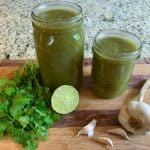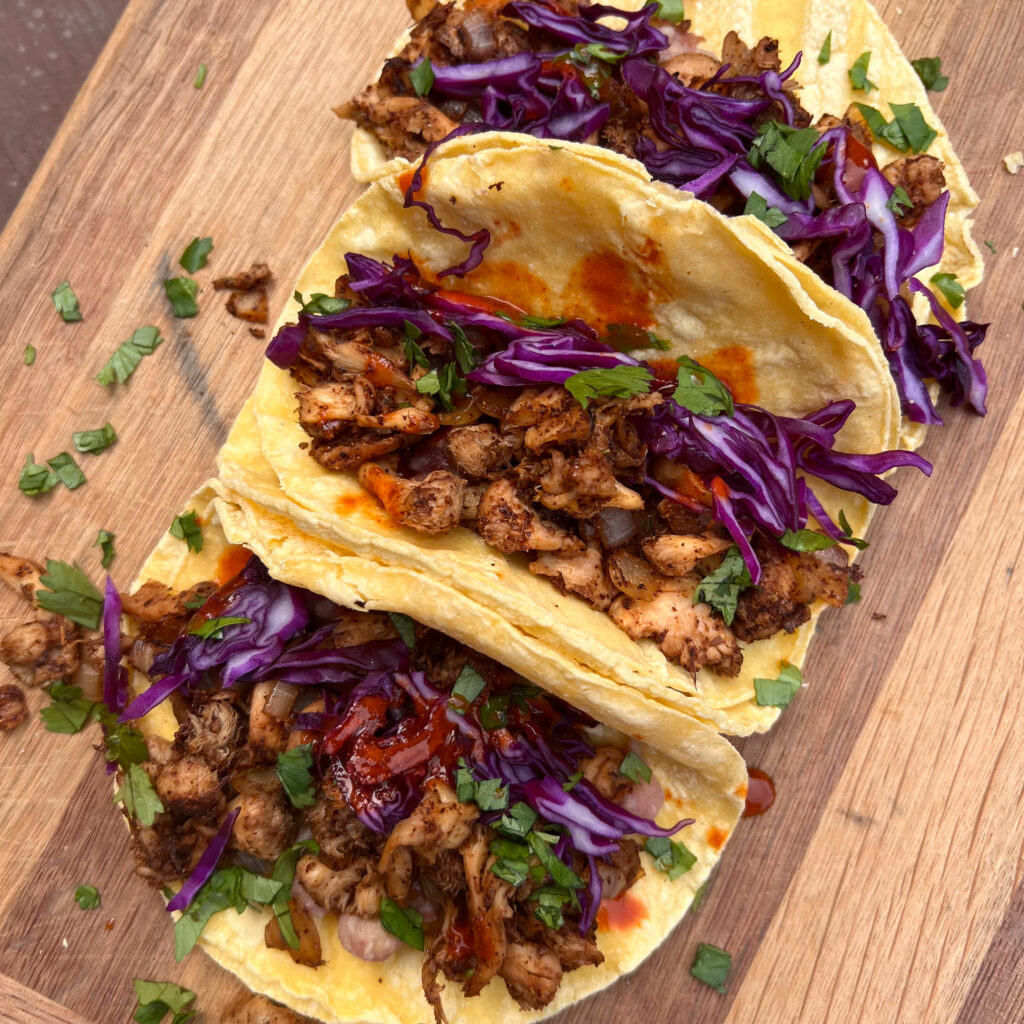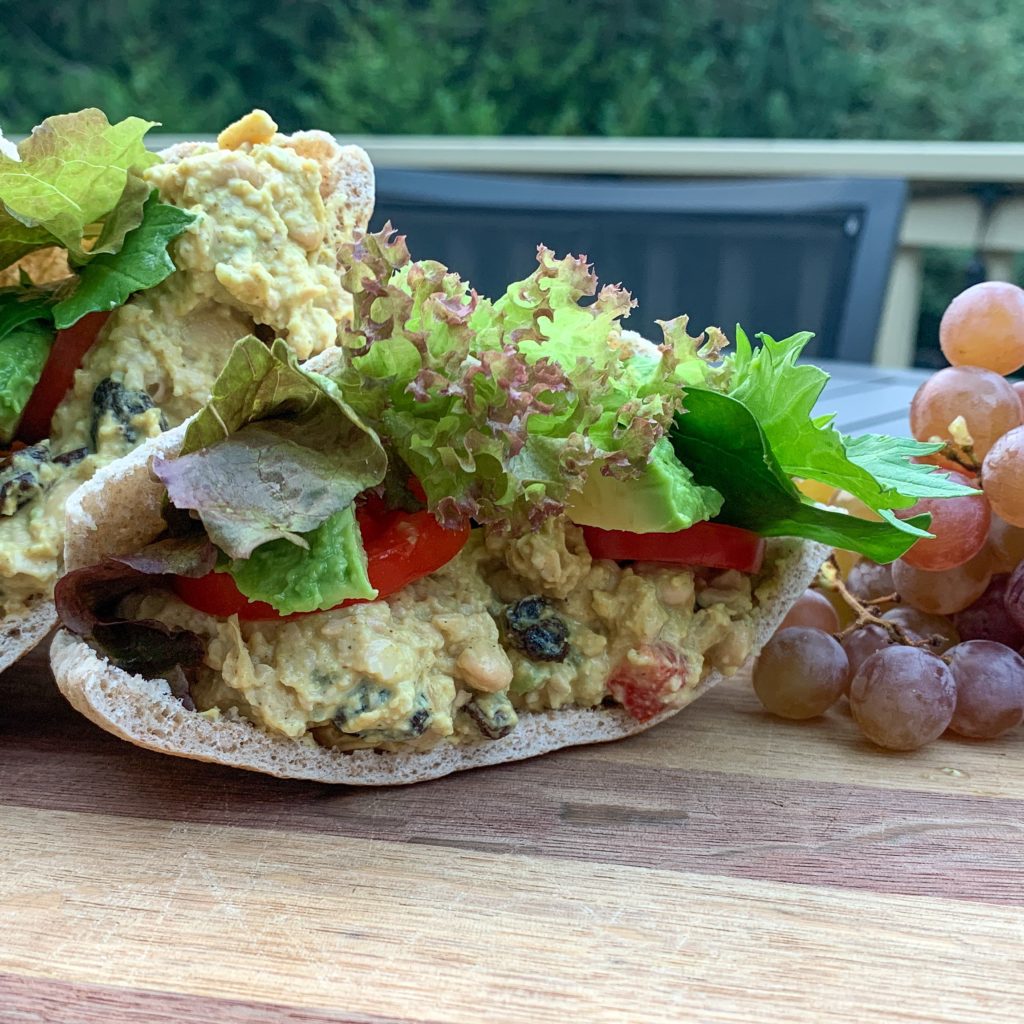Fresh Fava Beans & Fava Bean Pod Green Enchilada Sauce

Large fava beans inside a mature pod.
Admit it, you immediately thought of Hannibal Lecter, didn’t you?
Hannibal Lecter, Fava Beans and Chianti
Hannibal Lecter, Fava Beans and Chianti
Man, did Silence of the Lambs kill fava beans.
Silence of the Lambs scared the hell out of me when it came out, and it still scares me! I’m not a scary movie lover at all (my sister-in-law, Nikki, has to see every horror movie that comes out!) and I didn’t mean to watch it when it came out in 1991, it just happened by accident. It was my sophmore year in college at Central Washington University, Halloween night and my partner-in-bassoon-playing-crime Cheryl and I went to a Halloween party, dressed as Raggedy Ann and a Japanese Hakata doll, with a whole bunch of other music students (Cheryl and I made my costume from what we found at a local thrift shop and she made the wig for me out of a skein of yarn and a woolen knit cap! It was my favorite costume, ever!). And at some point, someone started the movie, and despite being dressed as a doll, I didn’t want to be a baby and leave the party.

We were posing like the dolls, me all floppy like Raggedy Ann and Cheryl, demure as a Japanese Hakata doll!
By the time the movie and the party was over, we were scared out of our wits and it was time to walk home. It had snowed a ton during the night and it was all creepy quiet, you know how it is on a snowy night. Cheryl and I walked to the big empty parking lot of Hertz Hall, the music building, midway between her apartment and my dorm, jumping and shrieking at every sound, including the soft thud of clumps of snow falling from the trees, but we just couldn’t separate and walk alone to our respective places! It didn’t help that I had to walk past the infamous Bundy Bridge, where serial killer Ted Bundy abducted one of his victims only 17 years before! One of us had the bright idea of going sledding instead of leaving each other, so we commandeered a cafeteria tray and spent the rest of the night speeding down hills in campus…it might have been the Rainier Beer! Best. Night. EVER!

“Wait, Raggedy Ann can’t be holding a beer in a photo! Lemme take that!” We were four dolls: Raggedy Ann, Japanese Hakata, Jessica Rabbit, and Betty Boop.
I still can’t think of fava beans, which I love, without thinking of that movie and that awesome night.
About Fava Beans
Fava beans, also known as broad beans, are thought to have originated in the Mediterranean. They’re common in wintertime gardens, growing well in cold temperatures, and are often included in cover crops, as they put vital nitrogen back into garden soil. The plant itself grows about three feet high and produces big pods with about 4-5 beans inside. When they are young, in early spring, the whole pod can be picked and eaten like common green beans, but as they mature, the pods get tough and stringy.

Large fava beans inside a mature pod.
The beans, themselves, are encased in a skin that gets tough and leathery as they develop within the pods. When the individual beans are less then about 1/2-inch long, this skin is edible, but gets too tough to eat when they get bigger. This will be the case of fava beans you find in markets in late spring and summer. These tough skins don’t make for good eating and need to be removed if you want to eat the bigger beans, which are still delicious. I once watched an episode of Chopped where chef contestants unfamiliar with the fava beans in their secret basket served them unshucked to unhappy judges! Peeling the beans can be time consuming, but they are so delicious that I think it makes it worthwhile.
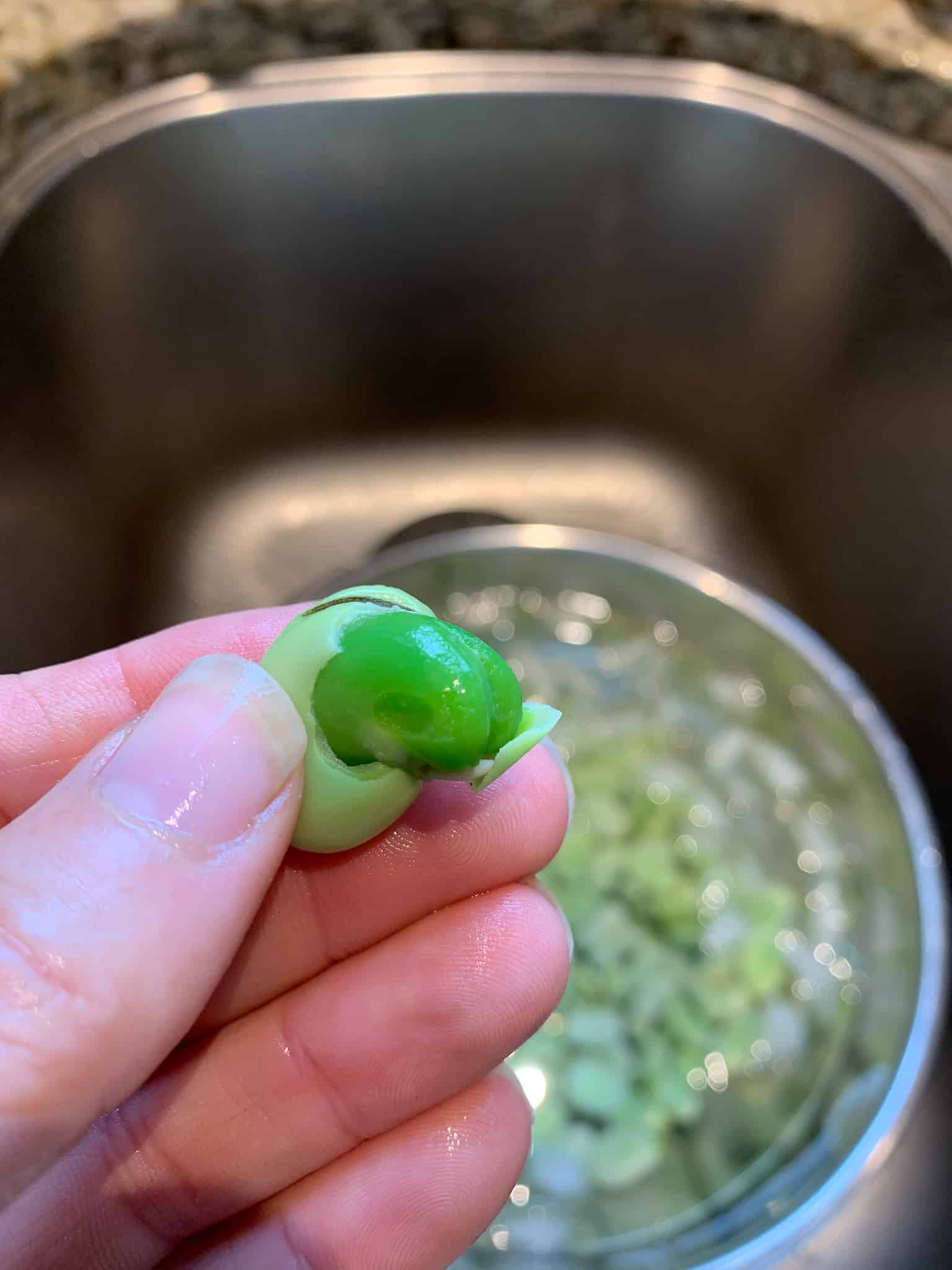
Tender fava bean freed from its tough outer skin.
Mature fava beans are often dried for use in soups and stews. You can find them in their dried form or cooked and canned. I will go over using dried fava beans another time.
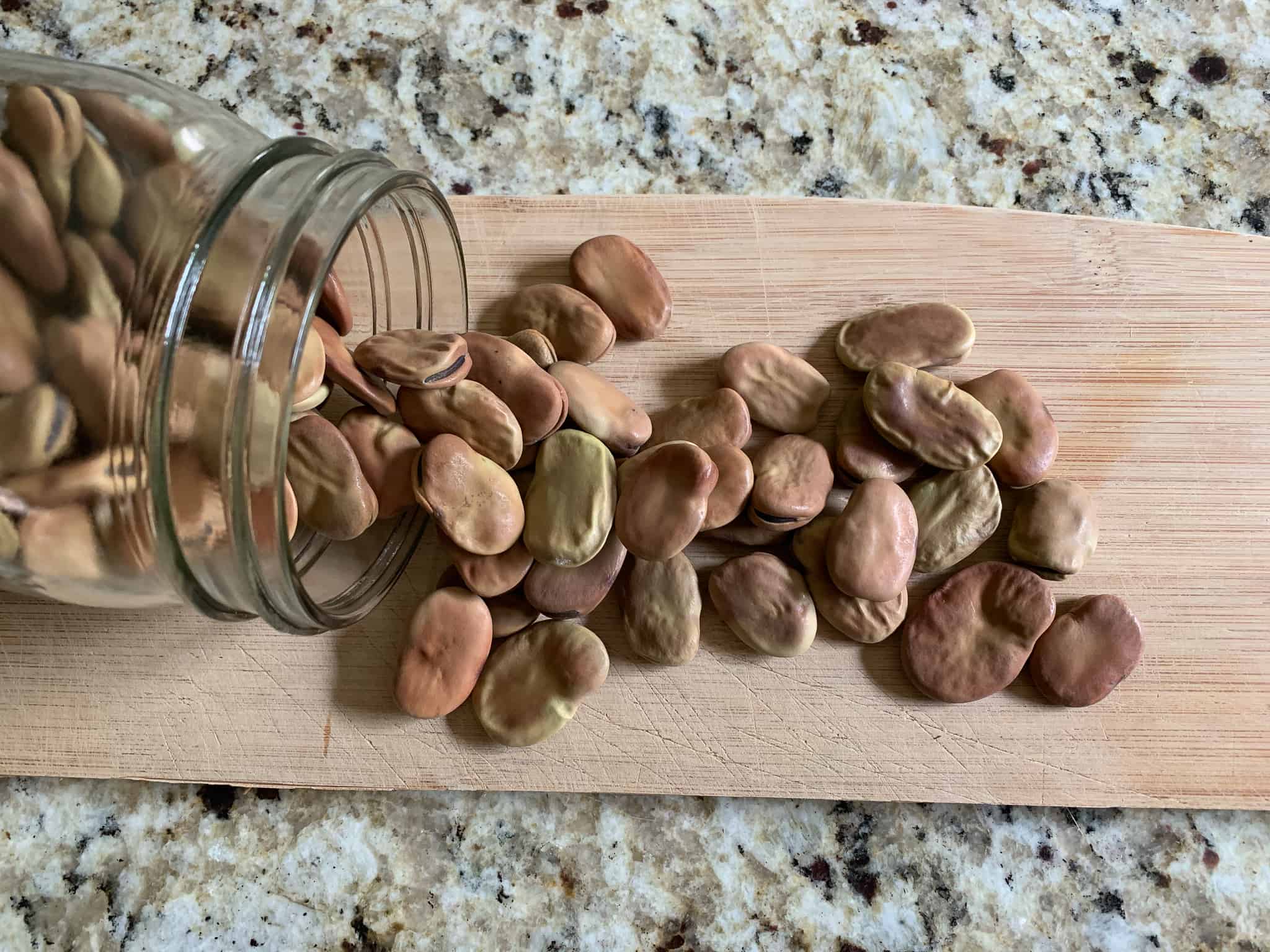
Dried mature fava beans.
Store fresh fava beans in your refrigerator, in paper, up to 10 days.
Fava beans are high in fiber, protein, and many vitamins and minerals. Per cup, cooked, fresh fava beans contain (data from the USDA):
- 187 calories
- 13 g protein
- 9.2 g dietary fiber
- 3 g sugar
- 61 mg Calcium
- 2.5 mg Iron
- 73 mg Magnesium
- 212 mg Phosphous
- 456 mg Potassium
- 177 µg Folate
- 26 IU Vitamin A
- 4.9 µg Vitamin K
There are some issues with fava beans that people need to be aware of. Although rare, some people are genetically unable to digest fava beans as they lack an enzyme needed to process them. The disorder is called favism, and can occur in people, mostly males, of Mediterranean descent, as well as decendents from Iran, Iraq, southeast Asia, and Africa, and can cause rupture of red blood cells, leading to illness, and sometimes death from kidney failure. It affects approximately 400 million people and can be discovered through genetic testing.
Fava beans are also high in a substance called tyramine, a monoamine, which comes from the breakdown of the amino acid, tyrosine. Tyramine is a common migrane trigger, so it may be something you want to limit or avoid should you suffer from migraines. And here’s a hidden meaning of the line in Silence of the Lambs about Hannbal Lecter eating liver, fava beans, and chianti—it’s actually a medical joke, implying that Hannibal Lecter isn’t taking his antipsychotic medications. Liver, fava beans, and red wine are all high in tyramine and contraindicated foods for patients taking a class of medications called Monoamine Oxidase Inhibitors, MAOIs, often used to treat depression and personality disorders. High levels of tyramine can cause extremely high blood pressure and be fatal!
But most people don’t have a problem with fava beans.
Preparing Fresh Fava Beans
Fresh fava beans have a sweet, creamy, earthiness to them and are definitely worth picking up if you see them at your farmers market or grocery store. They taste like a cross between green peas, asparagus, and edamame, and go great in salads, pasta dishes, and puréed to spread on crusty bread. My favorite thing is to add them to sautéed mushrooms and toss together with fresh pasta. One pound of fava pods will yield about 1 cup of tender, peeled beans.
To prepare them, set a pot of water to boil and prepare a bowl of ice water.
Remove the beans from the pods. Keep the pods for making Green Enchilada Sauce (recipe below) or compost them.
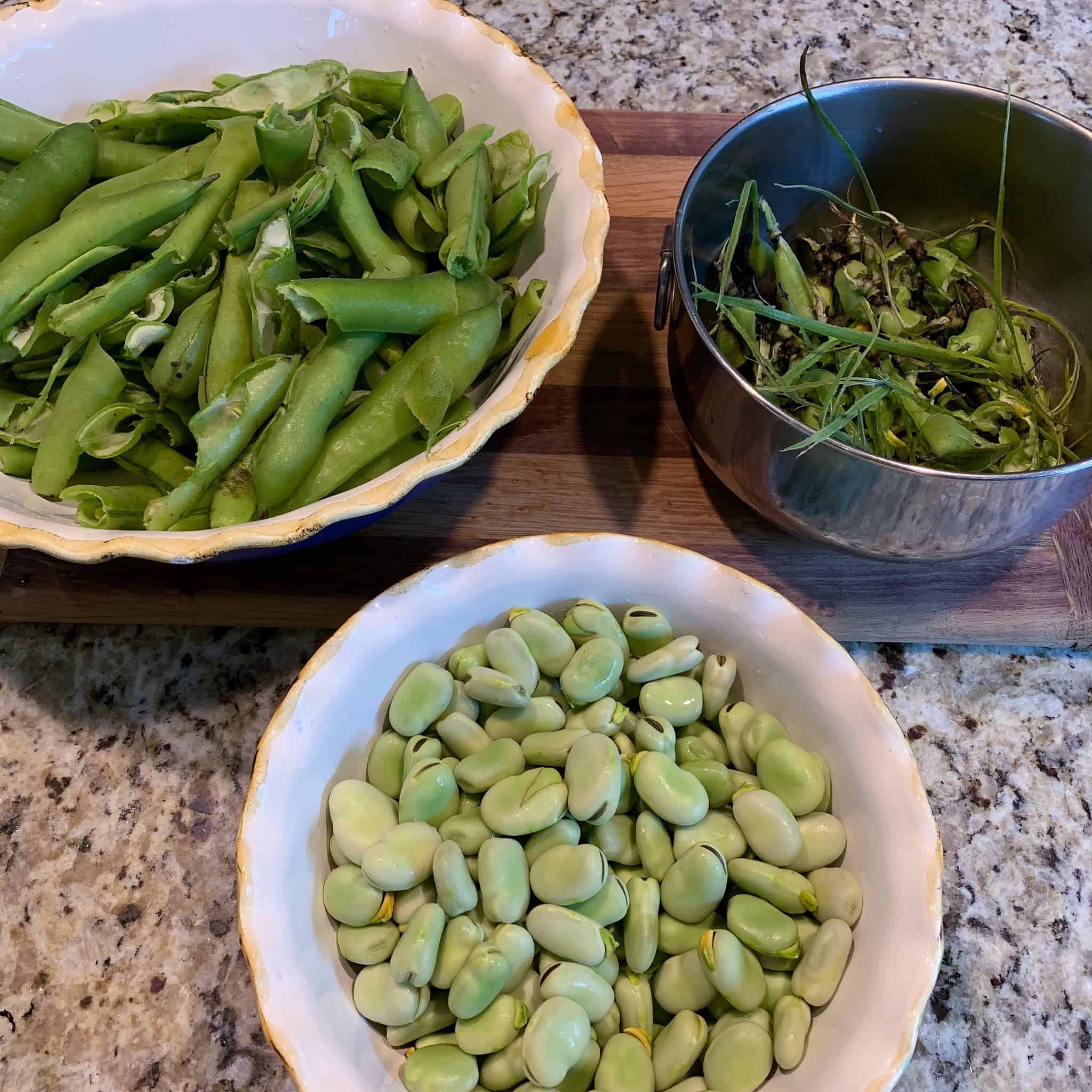
Fresh fava beans, pods (top left), stems and strings (right), unpeeled beans (center).
Once the water comes to a boil, add the shelled beans and blanch for 1 minute. Immediately pull the beans out of the water and plunge into the ice bath to stop the cooking process.
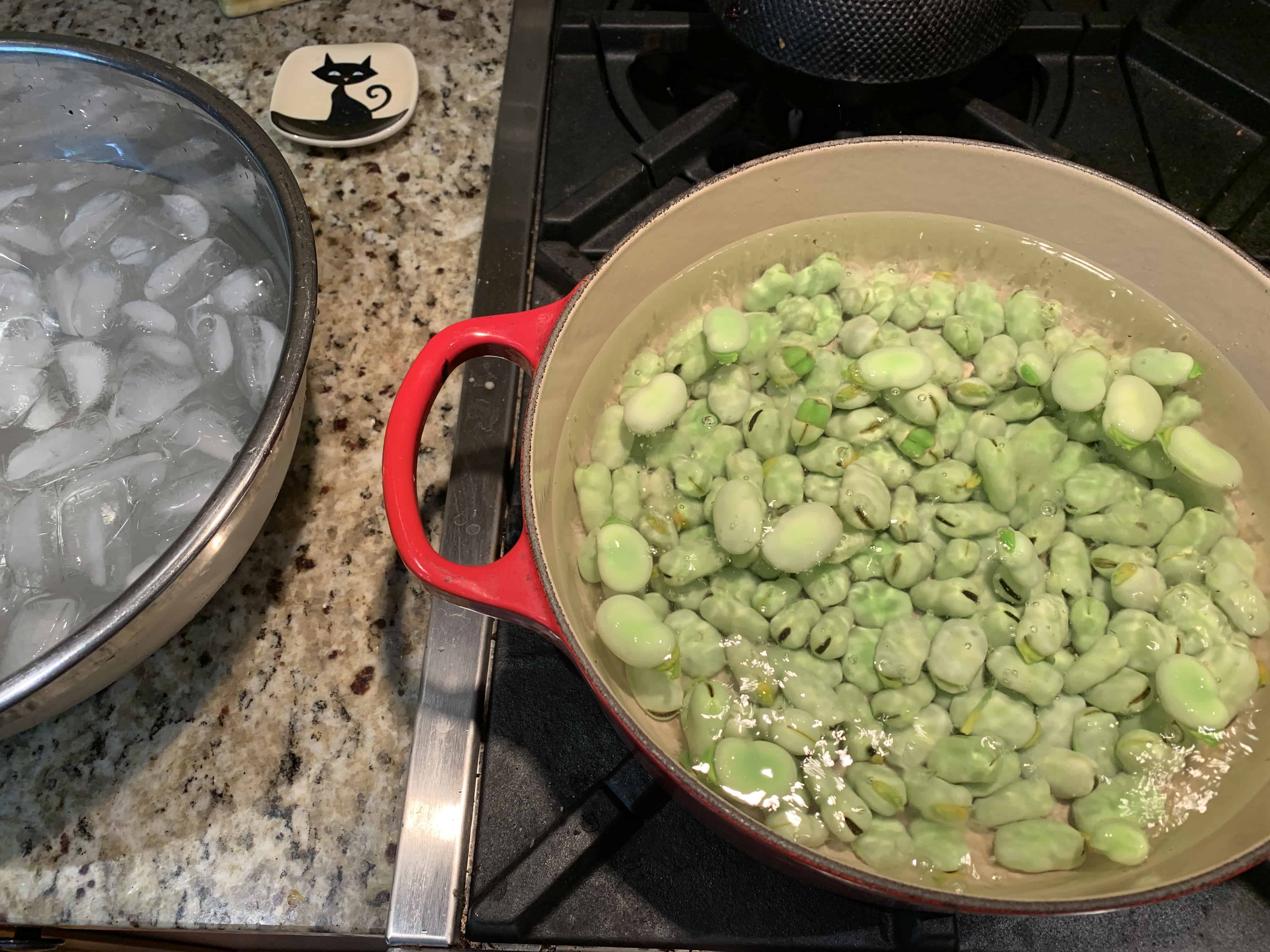
Boil unpeeled fava beans for 1 minute, then plunge into an ice bath.
Once cool, peel the tough outer skin and discard in your compost. You can snack on these skins, if you want, but they’re not particularly delicious.

Tender fava bean freed from its tough outer skin.
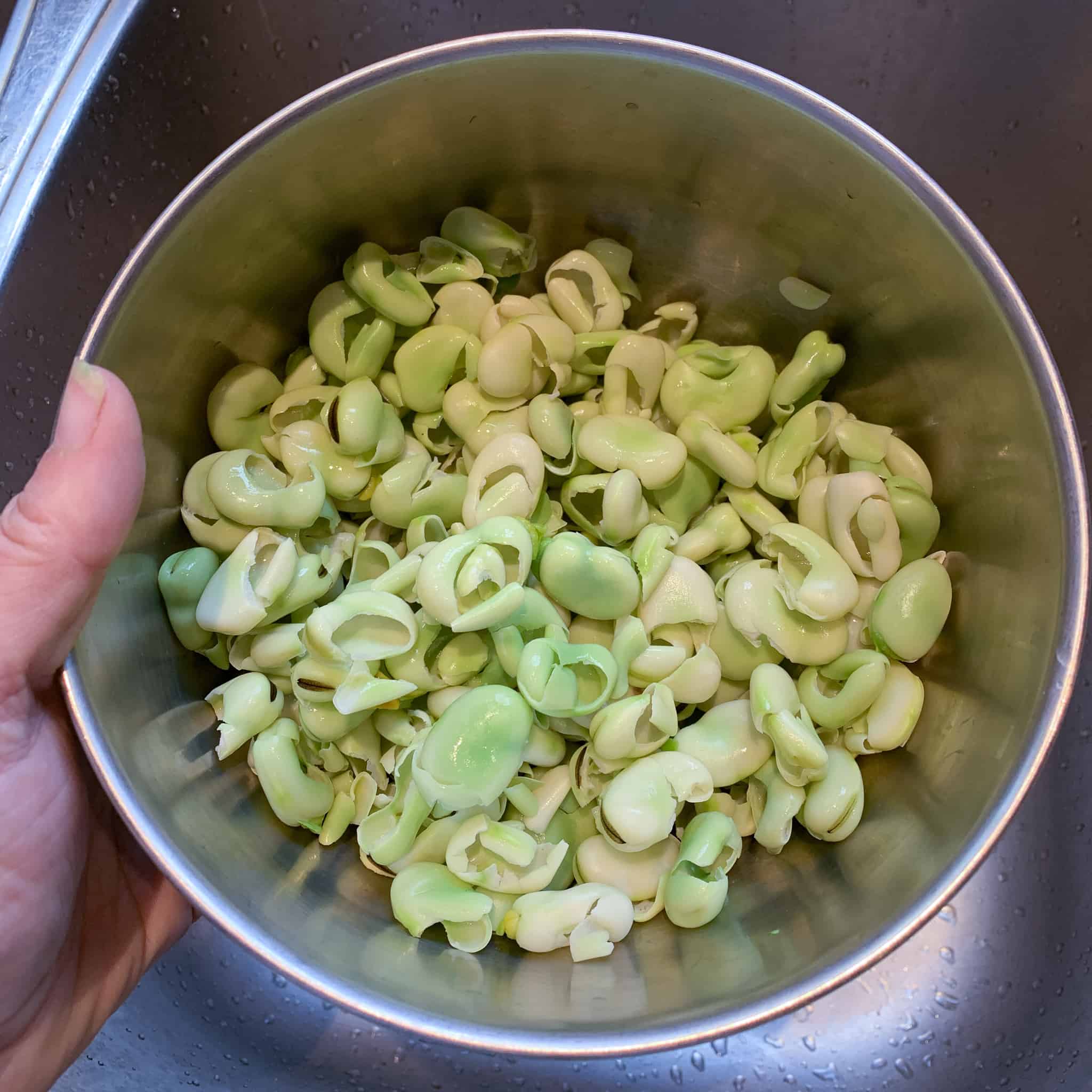
Tough skins removed from the tender fava beans.
Use the peeled beans as desired.
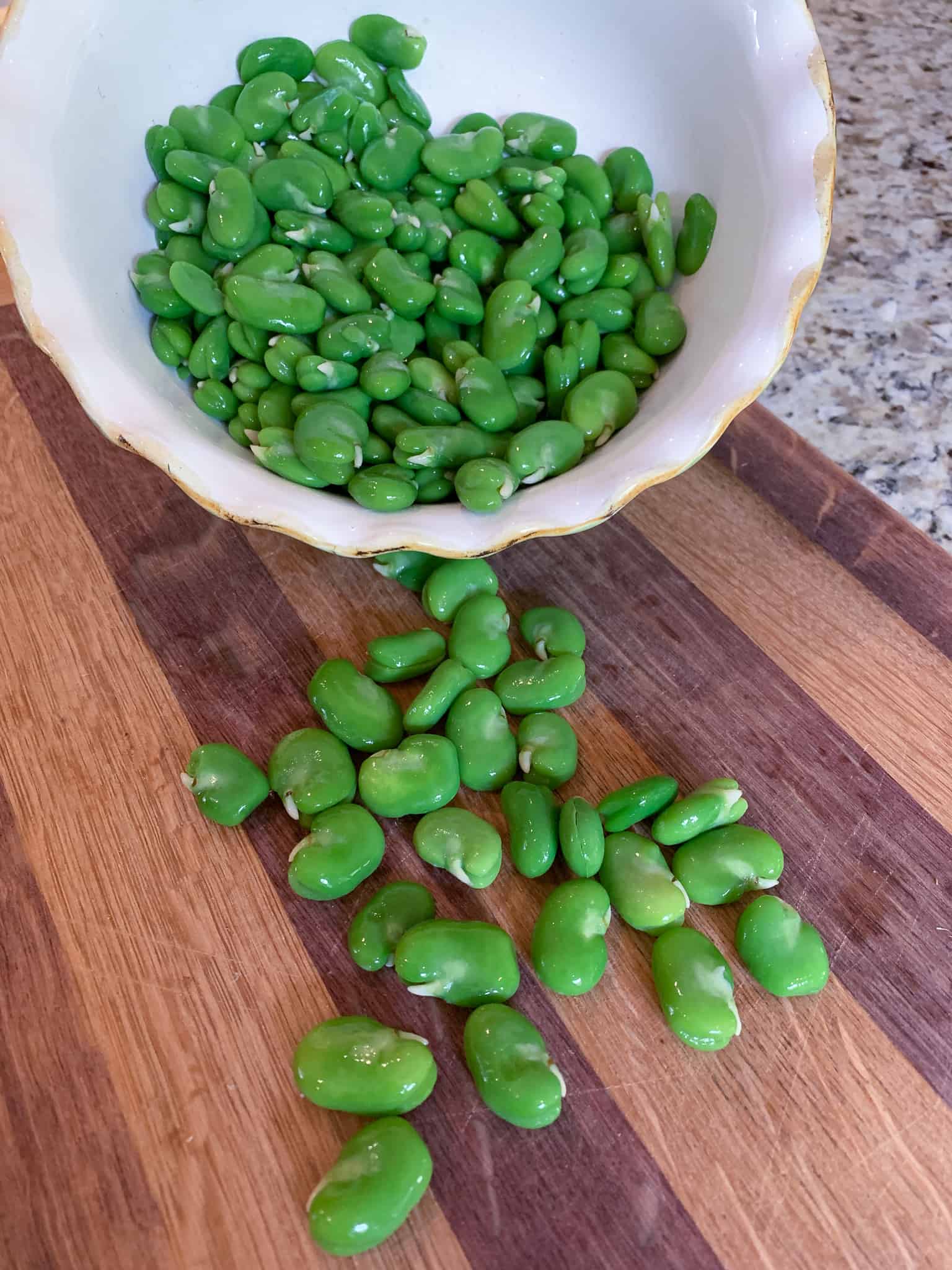
Brilliant green, tender peeled fava beans.
Using the Pods
Most people discard the tough fava pods. However, there’s a lot of material there and I wondered if I could use them for anything as the shucked pods account for nearly half of the weight of the fava beans you buy whole! I’ve discovered that once cooked, these pods have a distinct flavor that pairs well with Mexican cuisine.
I use my Instant Pot to cook these tough pods until tender. Add them to the inner pot fitted with a trivet and 1 cup of water. Cook them on high pressure for 10 minutes and do a rapid release when they are done. Alternatively, you can steam on the stovetop for 20-30 minutes but I think the pressure cooker does a better job.
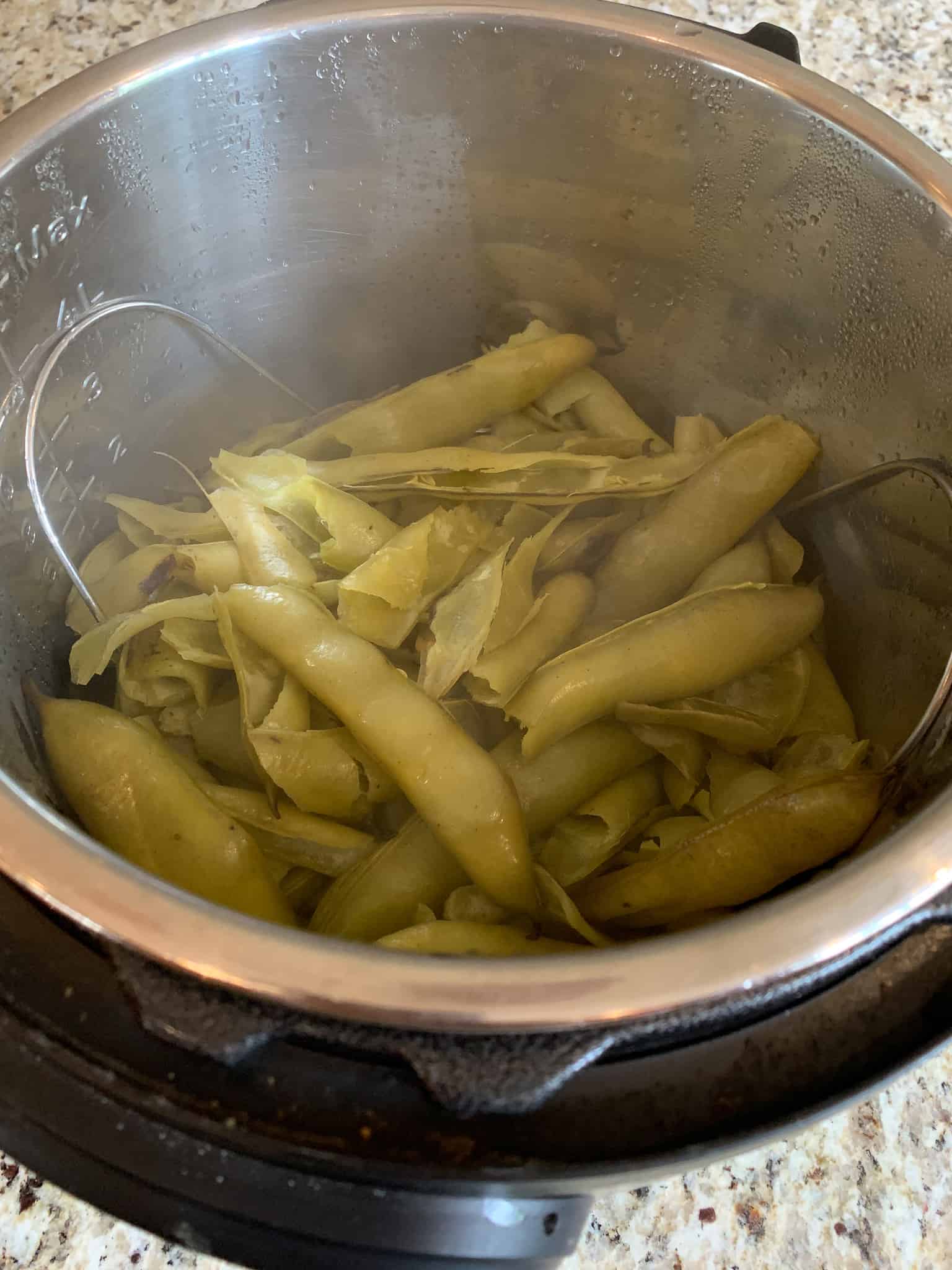
Steamed fava bean pods.
Once steamed, blend them in a food processor with onions, jalapeno, garlic, lime juice, cumin, oregano, salt, fresh cilantro, and vegetable stock to make a wonderful green enchilada sauce! Note, I don’t recommend using a Vitamix to blend this as there are some errant bean pod strings that may wrap around the center spindle of the blades and be nearly impossible to get out (learn from my experience!), so use a food processor or a different blender that you can easily take apart and clean the strings out of. Once blended, strain the sauce through a colander or sieve to get any leftover strings out before using. It is so much like enchilada sauce made from tomatillos that no one will ever be the wiser.
I love fava beans. It’s too bad they’ve gotten such a weird reputation from a movie reference, because they are simply delicious! They do take a bit of work to prepare, but I think the effort is well worth it. And, if you use the pods, you’re getting more bang for your buck than simply using less than half of this wonderful vegetable. I hope you give it a try!
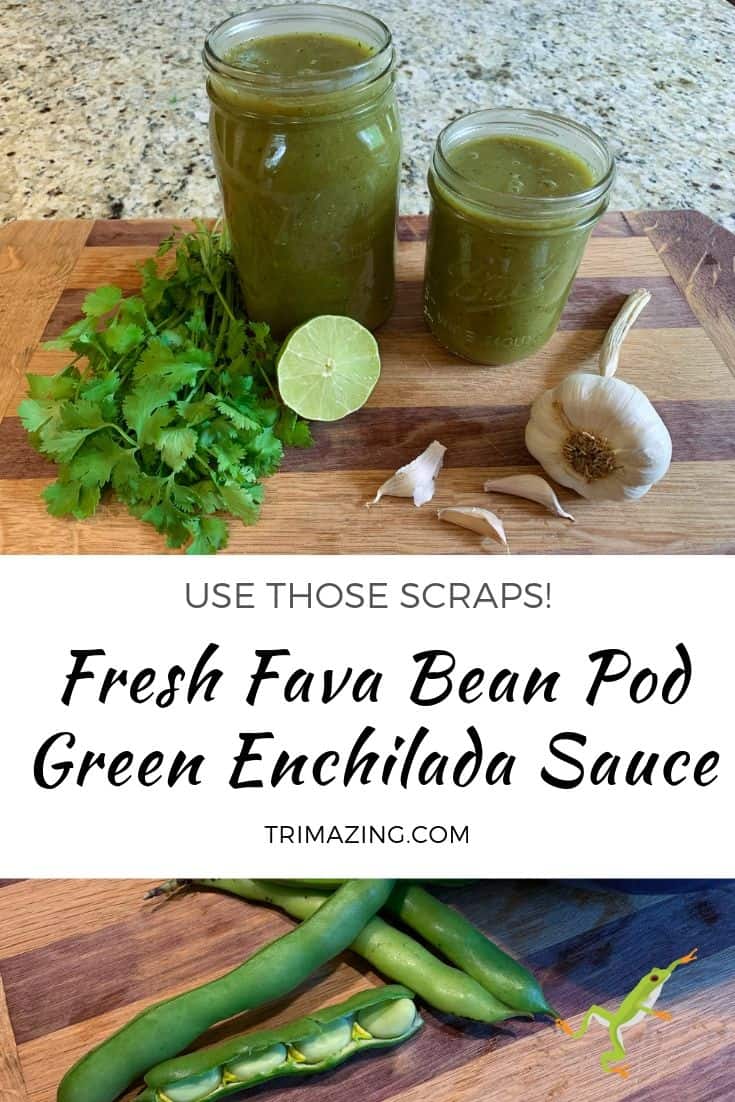
Fresh Fava Bean Pod Green Enchilada Sauce
Ingredients
- Shelled pods of fresh fava beans from 2½ pounds of beans
- 1 small onion chopped
- ½ jalapeno pepper seeded, veins removed, chopped.
- 4 cloves garlic chopped
- 1½ fresh limes juiced, about 3 tbsp
- 1 tsp ground cumin
- 1/4 tsp dried oregano
- 1 tsp salt
- 3 cups vegetable stock or water
- 1 handful fresh cilantro leaves and stems, about 1/4 cup
Instructions
- Shell the fresh fava beans, reserving the beans for another use. Remove the hard stem end, pull out the long strings from the side of the bean, and discard into your compost.
- Add 1 cup of water to the bottom of your pressure cooker and place a trivet or steaming rack. Add prepared fava bean pods. Set the pressure cooker for 10 minutes at high pressure. Do a quick release when finished. If you do not have a pressure cooker, steam 15-20 minutes until soft.
- Meanwhile, cook the onions, jalapeno, and garlic in a dry pan over medium heat until they are nicely browned. Add a splash of water or vegetable stock if they start to stick or burn. You want the caramelized flavor of these veggies.
- Transfer the cooked bean pods and onion mixture to a high speed blender or food processor (note, a food processor may be easier to clean afterward as errant strings from the pods may get twisted around the center of your blender blades and take some extra work for cleaning).
- Add the rest of the ingredients and blend until smooth.
- Strain the mixture through a colander with large holes to remove and discard any tough strings that remain.
- Use the green enchilada sauce as desired. Keeps for up to 3 days in the refrigerator and freezes well.
Nutrition
Do you like this post? Please share....
If you liked this post, you might like one of these:
Categories:

[Trī-māz-ing]
Cindy wants you to be Trimazing—three times better than amazing! After improving her health and fitness through plant-based nutrition, losing 60 pounds and becoming an adult-onset athlete, she retired from her 20-year firefighting career to help people just like you. She works with people and organizations so they can reach their health and wellness goals.
Cindy Thompson is a national board-certified Health and Wellness Coach, Lifestyle Medicine Coach, Master Vegan Lifestyle Coach and Educator, Fitness Nutrition Specialist, Behavior Change Specialist, and Fit2Thrive Firefighter Peer Fitness Trainer. She is a Food for Life Instructor with the Physicians Committee for Responsible Medicine, Rouxbe Plant-Based Professional, and Harvard Medical School Culinary Coach, teaching people how to prepare delicious, satisfying, and health-promoting meals.
She provides health and lifestyle coaching at Trimazing! Health & Lifestyle Coaching. Cindy can be reached at info@trimazing.com.
Subscribe to the Trimazing Blog
Receive occasional blog posts in your email inbox.
Subscribe to the Trimazing Blog
Receive occasional blog posts in your email inbox.

